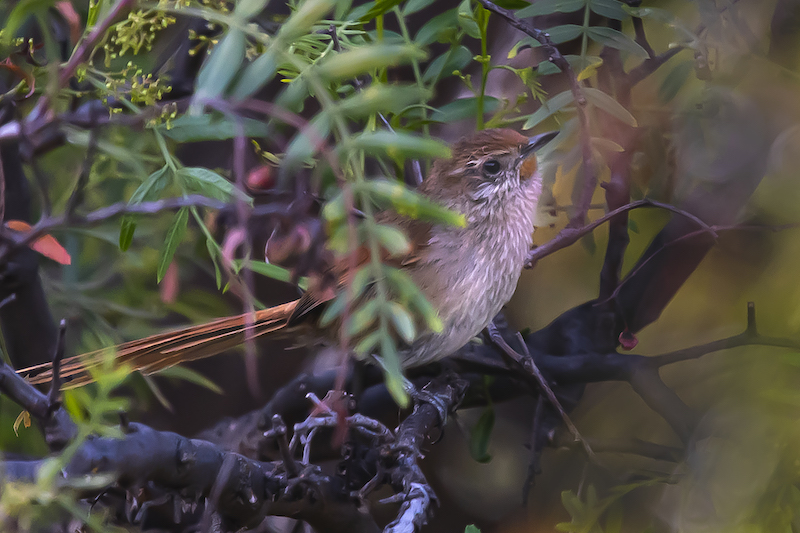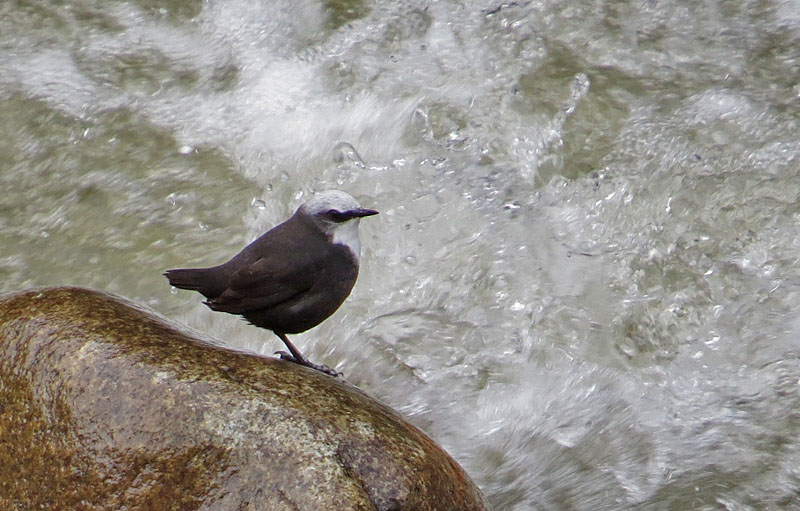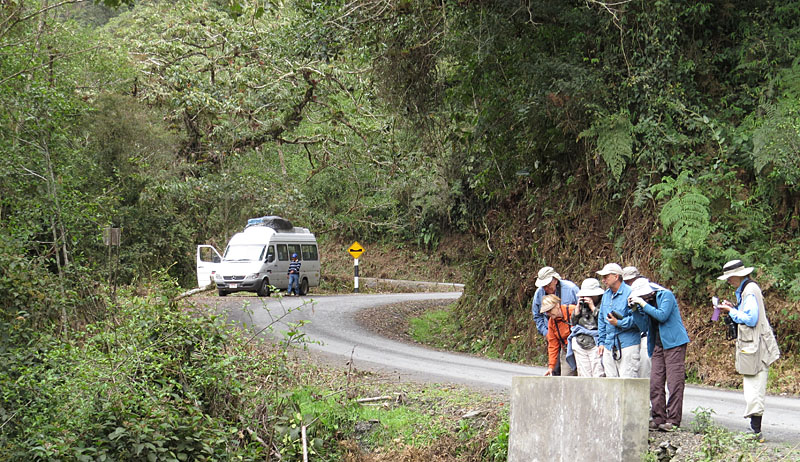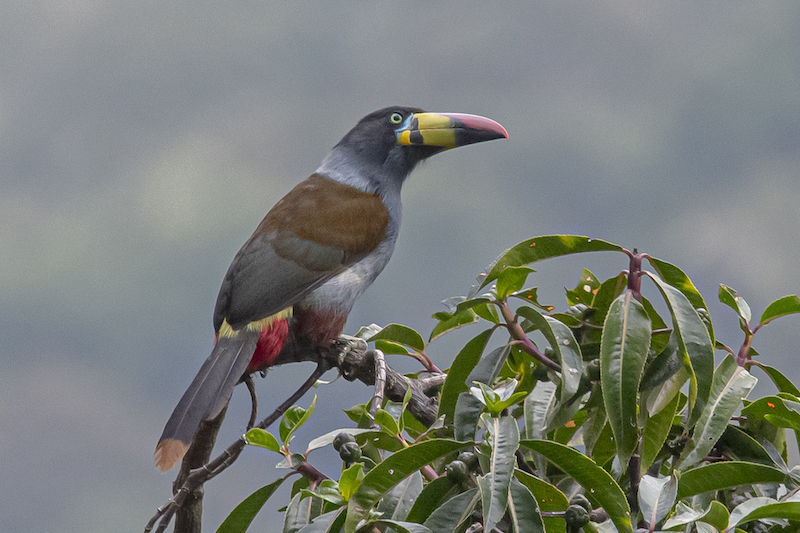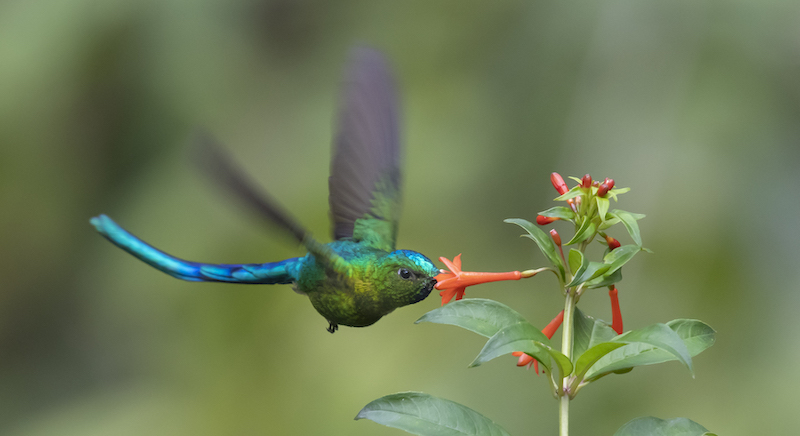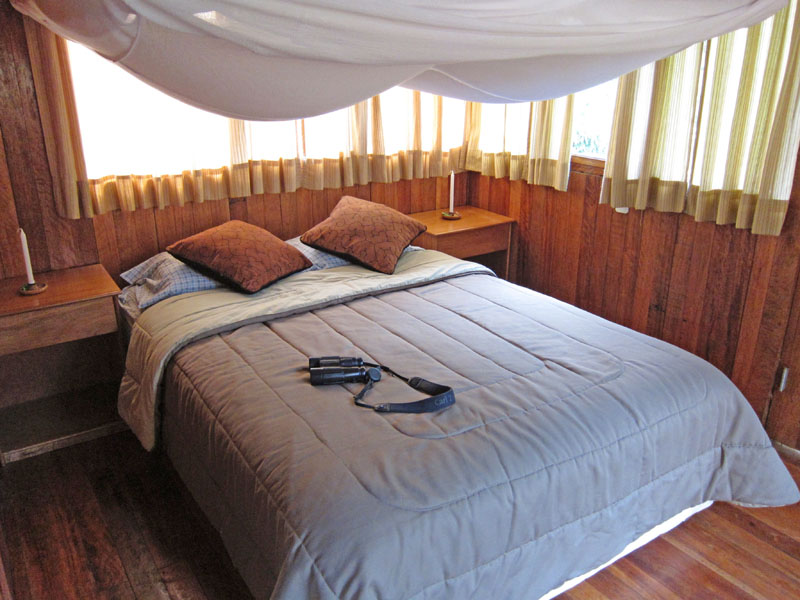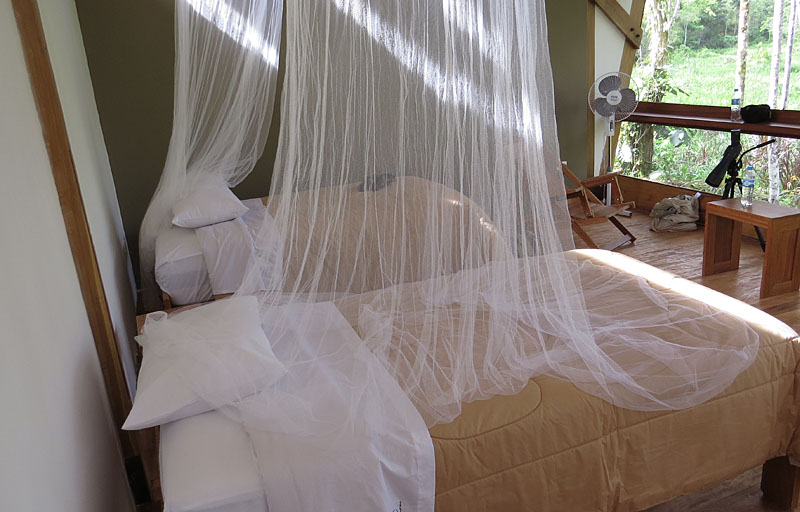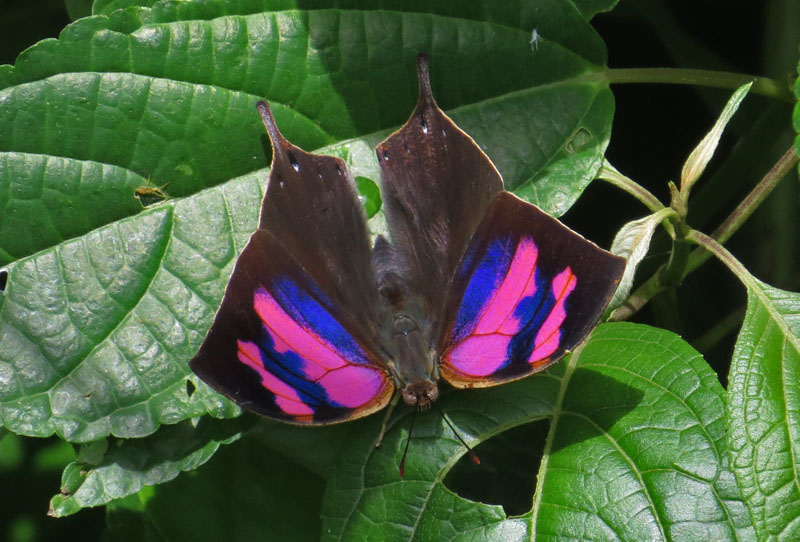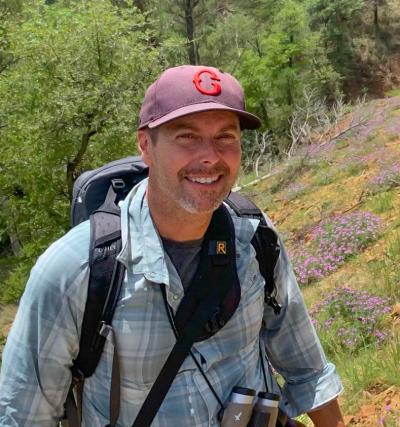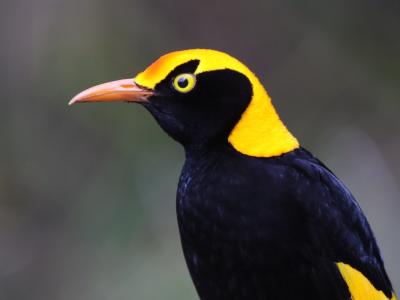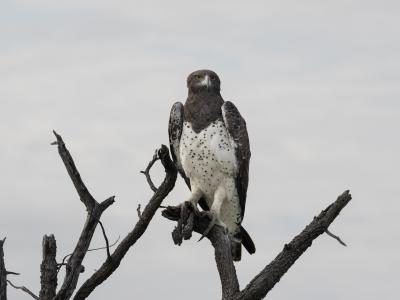Peru: Machu Picchu and the Manu-Kosñipata Road
The awe-inspiring Inca ruins of Machu Picchu need no introduction, and any birding trip to this region of Peru should include a visit. We’ll take advantage of our time here to bird the Urubamba River valley as well as some high-elevation lakes and marshes before continuing on to the Manu Biosphere Reserve, without question one of the most exciting birding destinations in the world. We’ll stay at three lodges at progressively lower elevations along the road that descends the Kosñipata Valley from Acjanaco Pass down to Pillcopata. We’ll visit protected habitats ranging from orchid-laden cloud forest at the upper elevations, to the rich middle elevations where Andean Cocks-of-the-rock perform their mating displays right along the road, down to the uppermost reaches of the navigable Amazon river system with its tropical exuberance.
This tour can be taken with our Rainforest Lodges of the Madre de Dios tour.
The awe-inspiring Inca ruins of Machu Picchu need no introduction, and any birding trip to this region of Peru should include a visit. We’ll take advantage of our time here to bird the Urubamba River valley as well as some high-elevation lakes and marshes before continuing on to the Manu Biosphere Reserve, without question one of the most exciting birding destinations in the world. We’ll stay at three lodges at progressively lower elevations along the road that descends the Kosñipata Valley from Acjanaco Pass down to Pillcopata. We’ll visit protected habitats ranging from orchid-laden cloud forest at the upper elevations, to the rich middle elevations where Andean Cocks-of-the-rock perform their mating displays right along the road, down to the uppermost reaches of the navigable Amazon river system with its tropical exuberance.
This tour can be taken with our Rainforest Lodges of the Madre de Dios tour.
Day 1: The trip begins at 6 p.m. in the lobby of our Lima International Airport area hotel. Night in Lima.
Day 2: We’ll fly early this morning to Cusco and board our bus for a day of birding as we work our way to the end of the road toward Machu Picchu. We’ll stop at a lake or two where we’ll likely see Andean Gull, Puna Ibis, White-tufted Grebe, and several kinds of ducks. Some of the birds inhabiting the rushes by the lakeshores could include Many-colored Rush-Tyrant, Wren-like Rushbird, and Plumbeous Rail, while nearby drier hillsides host the local Rusty-fronted Canastero and Bearded Mountaineer. Night in Ollantaytambo.
Day 3: We’ll depart very early this morning to catch the early train for our full day trip to Machu Picchu. From the train, we’ll see Torrent Duck and possibly White-capped Dipper on the Urubamba River, and on arrival, we’ll meet our local guide and board a bus for the short ride to the ruins, situated on a high ridge with spectacular views of the Urubamba River below. Our English-speaking guide will tell us about the geological and human history of the region as we spend a few hours slowly walking through the ruins, all the while watching for White-tipped Swifts overhead, looking for Inca Wren in the bamboo on the fringes of the ruins, and keeping an eye out for Northern Mountain Viscachas and Stenocercus lizards on the ruins themselves. After lunch, we’ll do some birding along the Urubamba River and have a brief opportunity to visit the gift shops before our late afternoon return train. Night in Ollantaytambo.
Day 4: We’ll depart by bus for the trip to the eastern slope of the Andes. We’ll make several stops as we climb over a couple of interior ridges and traverse some drier intermontane valleys before arriving at the last Andean pass, Acjanaco. Some birds we’ll likely see along the way include Mountain Caracara, Andean Flicker, Slender-billed Miner, and Mourning, Peruvian, and Ash-breasted Sierra Finches. Diversity increases as the habitats become moister and denser, with the endemic Creamy-crested Spinetail and very local Chestnut-breasted Mountain Finch possible. Near the pass, we’ll look for flocks in the patches of the humid treeline forest in hopes of encountering Scarlet-bellied Mountain Tanager, Golden-collared Tanager, White-browed Conebill, and Black-throated and Moustached Flowerpiercers. We’ll look particularly for Line-fronted and Scribble-tailed Canasteros, local species found only at high elevation or above treeline. As we descend the eastern slope of the Andes to our accommodations at 9400 feet, the forest becomes more continuous. The vast array of birds here includes White-collared Jay and Mountain Cacique, and we’ll hope to see mixed flocks of tanagers, flycatchers, and furnariids. In the evening we’ll go to a favorite spot where we’ve had good luck finding Swallow-tailed Nightjar. Night at Wayqecha Birding Lodge.
Day 5: At breakfast, we’ll be greeted by a dawn chorus of Great Thrushes, Glossy-black Thrushes, and Black-faced Brushfinches. We’ll have a full day in these uppermost elevations of the Kosñipata cloud forests, birding from the road that borders Manu National Park as well as on trails that enter the Amazon Conservation Association’s private reserve and research station. We’ll principally be birding along the road, almost certainly hearing Red-and-white Antpitta and Trilling Tapaculo, and with more than a bit of luck we’ll even see one or both. The lodge now has feeders, and possible hummingbirds here are the creatively named Shining Sunbeam and Amethyst-throated Sunangel, and other high-elevation specialties could include Gray-breasted Mountain-Toucan, Marcapata Spinetail, and Barred Fruiteater. We may return to Acjanaco Pass a few kilometers back up the road for any high-elevation birds we might have missed the day before, such as Puna Thistletail, Undulated Antpitta, Great Sapphirewing, or Grass Wren, the last an Andean resident recently split from North American Sedge Wren. Night at Wayqecha Birding Lodge.
Day 6: We’ll spend the bulk of this day making stops along the road, starting in the high-elevation cloud forests below our lodge at 9400 feet down to our next lodge at 4600 feet. Lower down, as we walk along this little-traveled road, we’ll keep an eye out for Masked Trogon, Crimson-mantled Woodpecker, Maroon-belted Chat-Tyrant, Inca Flycatcher, Blue-banded Toucanet, and a wide variety of other hummingbirds, flycatchers, and tanagers. The list of possible birds is all but overwhelming, and perhaps equally exciting are the myriad butterflies that come to seeps, puddles, and flowers. Lush, cloud-forest vegetation with flowers such as wild nasturtiums, fuchsias, Pitcairnia, and Bomarea (all attractive to hummingbirds) as well as fabulous vistas of undisturbed forest will make our day’s journey down the Manu Road memorable. Night in San Pedro.
Day 7: We’ll spend the day exploring the middle-elevation forests, concentrating on the habitats found from 6500 feet down to 4500 feet, home to many narrow-range specialties and an exceptionally comfortable climate. Birding these forests can be like visiting a bird buffet, with fancy quetzals and cotingas and mixed flocks of dazzling tanagers. Among the many possibilities are Crested and Golden-headed Quetzals, Amazonian Umbrellabird, Chestnut-backed Antshrike, Stripe-chested Antwren, Slaty Gnateater, Yungas Manakin, Andean and White-eared Solitaires, Deep-blue Flowerpiercer, and Golden, Paradise, Blue-necked, Golden-eared, and Orange-eared Tanagers. We sometimes get lucky with a troop of Geoffroy’s Woolly Monkeys in the roadside trees, and if it’s sunny, butterflies such as eighty-eights, jewels, and clearwings will continue to delight. We’ll visit a nearby Andean Cock-of-the-rock lek to watch up to ten or more males engaged in their strange mating dance at surprisingly close range. Hummingbirds at the lodge’s feeders and porterweed hedges should include Violet-fronted Brilliant, Many-spotted Hummingbird, and Booted Racket-tail, while Geoffroy’s Daggerbill, Wire-crested Thorntail, and White-bellied Woodstar are also possible at the flowers. We’ll also do some night birding here; we could find Rufescent Screech-Owl and Band-bellied Owl, but the real treat will be the Lyre-tailed Nightjar show: watching a male Lyre-tailed swoop across the sky at dusk is truly awesome. Night in San Pedro.
Day 8: After a pre-dawn breakfast we’ll spend the morning birding the lower foothill forests where more mixed flocks are our target. We’ll pay special attention to the stretch between 4500 and 2500 feet, which has relatively untouched forest, a rarity in the Andes as the climate is ideal for raising cash crops such as tea, coffee, and coca. In the past, we’ve seen many species restricted to this upper tropical zone, including Peruvian Piedtail, Versicolored Barbet, Ornate Stipplethroat, Cinnamon-faced Tyrannulet, Ornate Flycatcher, Black-backed Tody-Flycatcher, and Chestnut-breasted Wren. On one stretch of the road we’ll search for the Inti Tanager, first documented on WINGS tours in 2000 and 2003 and described finally in 2021. We’ll arrive at our next lodge with plenty of time to settle in before some late afternoon birding close to our rooms. Night at Villa Carmen.
Days 9–10: We’ll spend two full days at Villa Carmen. This birding lodge and biological research station owned by the Amazonian Conservation Association is in the transitional zone where the last low foothills of the Andes begin to flatten out into the Amazon Basin proper; while many of the species are Amazonian in affinity, some that are limited to the outer foothills are found only here. The possibilities are almost endless and include Uniform Crake, Hoatzin, Blue-headed and Chestnut-fronted Macaws, Yellow-billed Nunbird, Scarlet-hooded Barbet, Cuzco Warbler, Bamboo Antshrike, Black-throated Antbird, Rusty-belted Tapaculo, Ringed Antpipit, Johannes’s Tody-Tyrant, Hauxwell’s Thrush, and Band-tailed, Round-tailed, and Fiery-capped Manakins—in a word, tons of birds. We’ll make a short drive one day to visit a hummingbird feeding station where we may find Rufous-crested Coquette, Koepcke’s Hermit, and many other species. We’ll have the chance to go night birding here as well, and we should hear and possibly see Tawny-bellied Screech-Owl, Black-banded Owl, and Common Potoo. Nights at Villa Carmen.
Day 11: We’ll have final early morning at our Villa Carmen lodge, perhaps watching a morning flight of macaws or even making an attempt at pre-dawn owling. We’ll then retrace our path back up the Kosñipata Valley with possible short stops as we spot activity that catches our eyes or ears. After a picnic lunch at Acjanaco Pass we’ll continue to Cusco. Night in Cusco.
Day 12: You’ll have the early morning on your own to see the sights of the beautiful historic center of Cusco, and perhaps do a bit of shopping. Those who participate only on this tour will have their flights back to Lima, where the tour concludes, while those continuing on the second tour will have a mid-day flight to Puerto Maldonado.
Note:The information presented here is an abbreviated version of our formal General Information for Tours to Peru: Machu Picchu & the Manu-Kosñipata Road. Its purpose is solely to give readers a sense of what might be involved if they take this tour. Although we do our best to make sure that what follows here is completely accurate, it should not be used as a replacement for the formal document which will be sent to all tour registrants, and whose contents supersedes any information contained here.
ENTERING PERU: For United States citizens, a passport valid on the day of entry and with at least one blank page for an entry stamp, and return airline ticket are required. Visas are not necessary, and recently tourist permits and customs forms have been dispensed with; only your passport will be stamped upon arrival. If this changes, and you are given an immigration form, keep the tourist permit stub with your passport at all times — it may be required for departure from the country.
A valid Yellow Fever vaccination is required if you are arriving from a country where the disease is a risk. See http://wwwnc.cdc.gov/travel/yellowbook/2014/chapter-3-infectious-diseases-related-to-travel/yellow-fever#1948 for more information.
COUNTRY INFORMATION: You can review the U.S. Department of State Country Specific Travel Information here: https://travel.state.gov/content/travel.html and the CIA World Factbook here: https://www.cia.gov/the-world-factbook/. Review foreign travel advice from the UK government here: https://www.gov.uk/foreign-travel-advice and travel advice and advisories from the Government of Canada here: https://travel.gc.ca/travelling/advisories.
PACE OF THE TOUR: Sunrise in southern Peru this time of year is around 6:00 a.m. and sunset is at about 5:40 p.m. We plan to be in the field at dawn, with breakfast at about 5:30 each day in order to be out during the best birding hours. Except on travel days, we schedule time off after lunch for an hour or so before a late afternoon outing. We always have at least an hour off before dinner each day and typically end most days, having eaten and completed the day’s bird lists, by 8 p.m. On some days, we’ll schedule optional owling/nightjar outings either in the evening or before dawn.
We will be going over a pass at 13,700 feet (4170 m) on the first day of the tour where we will likely get out and look around bit, with short, easy walks. We’ll then spend time at a lower pass at around 11,500 feet (3500 m) and then end up at our lodge for the night at about 9600 feet (2925 m), and much of the next morning. After that we’ll continue downhill to much more comfortable elevations. Most, if not all, of our birding in the first few days of the tour will be done while walking on roads. At Villa Carmen almost all of our walking will be on trails. The longer walks are about two miles in length on even ground, but even on the shorter ones we go slowly and spend a lot of time standing and looking. Trails are mostly level, but there are some short but steep inclines where the trails cross ravines, and footing can be very unstable with rock and roots in places. Anyone with balance issues should carry a hiking stick.
When on the road we’ll be fairly close to the bus, but one should be prepared for long periods of standing and walking slowly. A small travel stool is handy for those who find this tiring. The forest trails may be muddy in spots and short roadside vegetation could be wet from dew or rains, so waterproof footgear is highly recommended – waterproof hiking boots or even rubber boots are best. If you don’t mind having wet feet, a cheap pair of sneakers would also work as long as you have something dry and clean to change into back at the room (or even in the bus).
HEALTH: The Centers for Disease Control and Prevention (CDC) recommends that all travelers be up to date on routine vaccinations. These include measles-mumps-rubella (MMR) vaccine, diphtheria-tetanus-pertussis vaccine, varicella (chickenpox) vaccine, polio vaccine, and your yearly flu shot.
They further recommend that most travelers have protection against Hepatitis A and Typhoid.
Malaria: The CDC considers Peru to be of low risk for travelers contracting malaria. While malaria is not common in the Manu area, it does exist, and the CDC has determined that a traveler who is on an appropriate antimalarial drug has a greatly reduced chance of contracting the disease.
Yellow Fever: Yellow Fever vaccination is recommended by the CDC.
Please contact your doctor well in advance of your tour’s departure, as some medications must be initiated weeks before the period of possible exposure.
The most current information about travelers’ health recommendations can be found on the CDC’s Travel Health website here: https://wwwnc.cdc.gov/travel/destinations/list
Elevation: This tour involves two days at elevations over 11,000 feet – one pass is at 13,700 feet (4170m). If you have a heart problem, please consult your doctor concerning these higher elevations. If you know you suffer from the more typical mild effects of elevation sickness (headache, nausea), we find that acetazolamide is a very effective drug (available in the US by prescription under the brand name Diamox or over the counter in Peru).
Insects: Many potential health problems can be prevented by adequate protection against insects. Even when mosquitoes may be sparse, biting gnats and chiggers can still be a nuisance. To be protected, bring plenty of spray repellent and wear long sleeves and pants when in the field. We recommend using insect repellents with a concentration of DEET of at least 20%.
Smoking: Smoking is prohibited in the vehicles or when the group is gathered for meals, checklists, etc. If you are sharing a room with a nonsmoker, please do not smoke in the room. If you smoke in the field, do so well away and downwind from the group. If any location where the group is gathered has a stricter policy than the WINGS policy, that stricter policy will prevail.
Miscellaneous: We do not often encounter snakes and take time to observe them whenever possible; most are not venomous, and venomous ones are not aggressive. At times we will be remote, and while the lodges have emergency medical supplies, professional medical assistance will be several hours away from some of them.
One can never completely escape the risk of parasites or fungal infections. Please consult with your physician. We avoid tap water but filtered and bottled water are readily available.
CLIMATE: At the time of our visit, the austral spring, coastal Lima is seasonally foggy, damp, and chilly, necessitating a sweater. Cusco, an Andean town, is cold at night and early in the day (potentially down to near freezing). During the afternoon, it can be very bright and sun protection should be used. At Wayqecha, morning could be in the low 40’s °F, but in the lowlands expect temperatures in the 70s to high 80s °F with high humidity. Rain is probable in the eastern Andes and lowlands. To deal with all climatic contingencies we recommend light gloves and a rain jacket that could double as a windbreaker and a sweater for the highlands and lightweight warm weather clothes for the lowlands. A compact umbrella is essential for birding in light rain.
ACCOMMODATIONS: Our hotels and lodges are always among the best available, comfortable and modern, and all have rooms with private baths. In Lima, we’ll stay in a standard modern airport hotel. Elsewhere on the tour, our accommodations are more basic eco-lodge quality, but still very nice, wooden construction with hot water and private baths. Single accommodation cannot be guaranteed at Villa Carmen; please consult the WINGS office for more details.
At Pillahuata, we stay at Wayqecha Lodge, a biological research station perched on the edge of a wild ravine overlooking the endless cloud forest of the Kosñipata Valley. Facilities include 10 twin rooms (each with two twin beds). Each room has recently been remodeled to contain a private bathroom. Electricity for charging batteries is provided by generator from 6:00-9:00 p.m. (there are outlets in the rooms), and internet is available 24 hours at and near the dining hall. The elevation here is about 9,600 feet (2925 m); temperatures may drop to 45º F (7º C) at night, and in the humidity it can feel colder than that.
At San Pedro we’ll stay at either Cock of the RockLodge or Manu Paradise Lodge. Both are situated in the pristine cloud forest of the mountains of Manu just a few minutes’ drive from a spectacular Andean Cock-of-the-rock lek furnished with a viewing platform to observe these colorful birds during their dawn displays. Facilities at Cock of the Rock Lodge include twelve spacious bungalows with private toilets and two single beds in most cabins. There is no electricity in the rooms yet; lighting is by solar charged lantern, electricity for charging batteries and internet are available in the dining area only when the generator is running from 6:00-9:00 p.m. In There is a large dining area and lounge overlooking a feeding station for birds. Manu Paradise is more hotel-like with rooms in two adjacent two-story buildings that also house the dining room. Hummingbird feeders are also in the garden here. Hot water is provided by gas heaters in all places.
Villa Carmen Research Station, just outside of the town of Pilcopata, has six beautiful, newly constructed cabins with private bathrooms, hot water, and full-time electricity in the rooms. Wi-Fi is available in the dining area.
As is typical in the tropics, occasionally, small lizards, amphibians, mammals, or unusual insects may visit a hotel room, especially in the lower elevations.
INTERNET AND MOBILE PHONE ACCESS: Mobile phone access is rather limited on this tour and is only available in and around Lima and Cusco, though some might find service at Villa Carmen. Wifi internet is available at all of our hotels but is limited to the generator hours of 6:00-9:00 p.m. in San Pedro.
FOOD: Food on our southeastern Peru tours is quite good. We’ll start all days with warm breakfasts, almost always including scrambled eggs or an omelet. Lunches are either back at our lodge or, during transfer days, a boxed lunch prepared by the lodge, usually including something like a chicken-pasta dish, fruit, juice, and cookies. All dinners are at our lodges and, like the sit-down lunches, usually start with a delicious soup and then follow with a main dish with trout, chicken, or beef, rice, potatoes, cooked vegetables, and sometimes a salad. Dinners are followed by a simple dessert. We have no reservations about eating fresh vegetables or drinking beverages with ice at our lodges, which cater largely to foreigners like ourselves. A couple of our lodges have only a very limited selection of alcoholic drinks available, though all have beer and wine, and can also prepare pisco sours, the Peruvian national cocktail.
Drinks: Bottled water and/or a soft drink or a beer is provided at lunch and dinner, as is coffee or tea. All other drinks or ‘personal’ drinking water for use in your room etc. is the responsibility of the individual; our lodges typically have filtered water available for refilling your own bottles. We also keep bottled water on the bus for ‘emergency’ use during the day.
Food Allergies / Requirements: We cannot guarantee that all food allergies can be accommodated at every destination. Participants with significant food allergies or special dietary requirements should bring appropriate foods with them for those times when their needs cannot be met. Announced meal times are always approximate depending on how the day unfolds. Participants who need to eat according to a fixed schedule should bring supplemental food. Please contact the WINGS office if you have any questions.
TRANSPORTATION: The flights to Cusco and back will be in modern, full-sized jets (such as an Airbus 320), and our transportation from there will be in a small bus provided by our ground agent. Most road travel will be on an unpaved, often bumpy road, but we are fortunate just to have roads into this fabulous area. Some roads may be quite bumpy and/or winding; anyone susceptible to motion sickness should bring an appropriate remedy. Participants should be able to sit in any seat in our vehicles.
2022 Narrative
We packed in a lot of memorable bird sightings in our ten days of birding in the department of Cusco. Of the tour best sightings, a super close view of Inca Wrens at the stunning ruins of Machu Picchu; a lovely Urubamba Antpittas in the deep, mossy interior of the short forest at Wayquecha; a super cute Peruvian Piedtail at the Cock of the Rock Lodge’s flowers, somehow managing to grab a sip despite the super aggressive Sparkling Violetears; the unforgettable Andean Cock-of-the-rocks at their lek; the amazing views of males of both Swallow-tailed and Lyre-tailed Nightjars; the pond ‘filled’ with Hoatzin at Villa Carmen; and an unexpected Buckley’s Forest-Falcon seen so well at Villa Carmen too.
Other fantastic species found on this trip included Bearded Mountaineer, Rufous-crested Coquette, Wire-crested Thorntail, Semicollared Hawk, Black-streaked Puffbird, Gray-breasted Mountain-Toucan, Blue-and-yellow Macaw, Slaty Gnateater, Barred Fruiteater, loads of tanagers and more! Rounding out the tour were the additional aspects of natural history, such as so many butterflies and interesting mammals, delicious regional food, and the wonderful Peruvians we saw and met.
After a night at the Lima airport hotel and an early breakfast, we flew to the busy city of Cusco. We met our driver Daniel, and immediately drove towards the nearby Huacarpay Lake. During the drive, we already spotted a few groups of Andean Gull and Puna Ibis. Once at the lake, we quickly found the beautiful Many-colored Rush-Tyrant together with the less colorful Wren-like Rushbird. In the nearby bushes, the endemic Rusty-fronted Canastero was singing and seen well, as a few Band-tailed Seedeaters and White-crested Elaenias. Driving around the lake, besides admiring our first pre-Inca ruins, we also found some Andean Lapwings, Spot-winged Pigeons, and a few Sparkling Violetears.
We then returned to Cusco, crossing the city to join the Piuray lake. There, we had an excellent picnic surrounded by superb Andean landscapes. From the picnic table we observed hundreds of Puna Ibis, and large numbers of Yellow-billed Pintails, Yellow-billed Teals, White-tufted and Silvery Grebes, Slate-colored Coots and a few Andean Ducks and Puna Teals. A Plumbeous Rail was also running in the open on the lake shore. In the reedbeds we could appreciate even better views on Many-colored Rush-Tyrants, Wren-Like Rushbirds and Yellow-winged Blackbirds.
After lunch, we drove towards the Sacred Valley. Following the Urubamba River for a few kilometers we reached the ‘Ensifera Camp’ where a nice Peruvian couple run a Hummingbird Garden. What a lovely place to spend the afternoon, watching Shinning Sunbeam, Green-and-white and White-bellied Hummingbird, Tyrian Metaltail, White-bellied Woodstar, Giant and Sword-billed Hummingbird!
After this fantastic first day in the Cusco Department, we drove towards our lovely hotel in Ollantaytambo.
We had an early breakfast before taking the train to Aguas Calientes. During the two hours of travel along the Urubamba River we counted no less than 45 Torrent Ducks! Once in the small but ultra-touristic village of Aguas Calientes we met our local guide Jesus. We immediately took a bus to the Machu Picchu ruins, spending all morning to discover this fantastique archeological site. The ruins are extremely well preserved and impressive, and we had the chance to do the visit under a wonderful blue sky! Between two photo stops, we also found some birds: a very cooperative Inca Wren came at less than two meters, two Black-winged Black-Tyrants, a few Sierran Elaenias, many Blue-and-white Swallows nesting in the Inca walls, and our first Blue-capped Tanager. Concluding a superb visit of this new wonder of the World, we had an excellent lunch tasting several Peruvian specialties!
After lunch, we walked back to Aguas Calientes to take the train, and of course did some birding on the way down. The bird activity was excellent and we found many mixed-species flocks, including Spectacled and Slate-throated Redstarts, Saffron-crowned, Silvery, Golden-naped and Beryl-spangled Tanagers, Barred Becards and Brown-capped Vireos! We also had nice views on Andean Guan, Blue-banded Toucanet and Andean Motmot. Just before arriving to Aguas Calientes, we had fantastic sights on all fast-running river specialists: Fasciated Tiger-Heron, Torrent Duck, White-capped Dipper, Torrent Tyrannulet and Black Phoebe! Stunning! It was now time to board the train back, and after our pleasant drive back we arrived at our comfortable hotel in Ollantaytambo for a succulent dinner.
We started our day with a beautiful drive in the Sacred Valley, where the sumptuous landscapes are speckled with Inca ruins! Obligatory stop in front of the ruins of Pisac! Leaving the Sacred Valley, a stop in the middle of the crops and some eucalyptus plantations was very fruitful: no less than four Chestnut-breasted Mountain-Finches that we observed nicely, as well as some Mourning Sierra-Finches, a nice flock of Hooded Siskin, some Band-tailed Seedeaters and even a Golden-billed Saltator was singing atop a tree. But the most beautiful surprise was the arrival of a magnificent Bearded Mountainner, which perched just a few meters from us! Unforgettable!
As we continued our journey, the breathtaking landscapes followed one another. We passed through many picturesque villages, where the inhabitants still live from small-scale agriculture, and often still wear traditional clothes.
Continuing our ascent, we left the forest limit and the agriculture, reaching the magnificent landscapes of the high mountain. There, we found a few of the beautiful Mountain Caracara, the superb Andean Flicker, Streak-throated and Streak-backed Canasteros, Spot-billed and Rufous-naped Ground-Tyrants, and even two Aplomado Falcons flew over us.
The journey was long, but we never tired of these beautiful landscapes. After a stop at the market of Paucartambo, last village for the next few days, we continued our ascent towards the pass of Acjanaco, entry door of the Manu National Park. From there, we could just drive down to the Amazon!
Our next stop was the Wayquecha biological station, where we stayed two nights. Just before arriving to Wayquecha, we found a beautiful troop of tanagers including Scarlet-bellied and Hooded Mountain-Tanagers, Grass-green and Golden-collared Tanagers, Three-striped Hemispingus and Masked Flowerpiercer! What a welcome surprise!
For our first morning in the surroundings of Wayquecha, we went very early to the pass of Acjanaco. There, we admire the sunrise over the Amazon, and the first sunrays were very welcomed to warm us up! Around the pass, apart from the absolutely incredible and fascinating high-altitude vegetation, we observed a couple of Grass Wren in the Stipa ichu clumps, some Brown-backed Chat-Tyrants, two Streak-throated Bush-Tyrants and a Cinereous Harrier. A Puna Tapaculo also came, attracted by the playback, and let itself be admired in full view!
After a long wait, we also had a large mixed-species flock, including White-throated Tyrannulet, Pearled Treerunner, Chestnut-bellied Mountain-Tanager, Rufous-breasted Chat-Tyrant and Moustached Flowerpiercer.
Back to the lodge for lunch, we appreciated a delicious meal in front of feeders attracting Amethyst-throated Sunangels, Violet-throated Starfrontlets, Chestnut-breasted Coronets, Long-tailed Sylphs and Lesser Violetears as well as Black-faced Brushfinch or Blue-capped Tanager. After a short break, we birded the lodge trail, where beside amazing orchids, we had a close encounter with a very cooperative Urubamba Antpitta offering stunning views and picture opportunity! On another trail belonging to Wayquecha we found a nice flock including a dozen Citrine Warblers, at least three Black-capped Hemispingus and a few White-banded Tyrannulet. Two Mountain Caciques together with three Hooded Mountain-Tanagers were also seen very well!
We spent the rest of the afternoon near the tunnels below Wayquecha, where we found a few new birds such as Superciliared Hemispingus or Cinnamon Flycatcher. A White-throated Hawk flew over the forest, panicking a large flock of Band-tailed Pigeons! And after a long search, a Yungas Pygmy-Owl was also admired for a long time while the fog started to cover the forest. To conclude this superb day, a magnificent male Swallow-tailed Nightjar offered us an incredible show by flying over us several times at nightfall!
After an early rise under the stars and no less than four planets overhead (Venus, Mars, Jupiter and Saturn), we started the morning by observing the birds around the lodge. One of the first species we found in the garden was a superb Gray-breasted Mountain-Toucan! Followed by a flock of Andean Guan who came to plunder the fruit-feeder and some White-collared Jay. We also found an immature Creamy-bellied Thrush in the garden, a rather unusual southern migrant at this altitude. Along the ‘Mirador trail’, we will also make a very beautiful observation of Sharp-shinned Hawk, of which an individual will land on an exposed perched just below our way. At the same place, a superb male of Rufous-capped Thornbill was also sparkling in the morning light!
During our way down for our next stage, the lodge of Cock-of-the-Rock, we did some stops at different altitudes, but the activity of the birds was very weak. We will realize during our descent that the temperatures remain very fresh, even at low altitude where it should begin to be warm, and that we were experiencing a ‘friaje’! A friaje is a climatic event which takes place occasionally in the South of Peru during the austral winter, and which corresponds to the movement of cold air from Patagonia towards the North. This drop in temperature usually begins with a rainy episode and can be followed by a few days of cold. Normally a friaje lasts about 3 days, but exceptionally, the friaje of June 2022 will last more than 2 weeks and all the rest of our trip will be done in unusual conditions. Because of these cooler temperatures (10-12 degrees Celsius below normal), the bird activity (vocalizations, response to the playback) was much quieter than normal. At the end, this friaje had little impact on the number of bird species observed during this trip, but we had to make extra efforts to find some of them!
On our way to Cock-of-the-Rock lodge, we found a fantastic mixed-species flock! No less than 30 species observed together, including Strong-billed and Olive-backed Woodcreeper, Buff-browed Foliage-Gleaner, Pearled Treerunner, Barred Becard, Inca Flycatcher, a Fulvous-breasted Flatbill, Golden-crowned Flycatcher, Mountain Wren, Short-billed and Common Chlorospingus, Black-faced Brushfinch, Three-striped Warbler, Spectacled Redstart, Slaty, Rust-and-Yellow, Yellow-throated, Orange-eared, Beryl-spangled and Saffron-crowned Tanager, Superciliared and Black-eared Hemispingus, Deep-blue Flowerpiercer, Gray-hooded Bush-Tanager, to name a few! Unforgettable! Another memorable discovery during our journey was a female Lyre-tailed Nightjar found on her day-roost on a small cliff along the road. A great photo opportunity!
Unfortunately, the rain associated with friaje started to fall soon, and obliged us to drive directly to the lodge just after lunch. The rain did not stop for the whole afternoon, but it did not prevent us from birding! Once at the Cock-of-the-Rock lodge, we spent the rest of the afternoon watching the birds coming to the feeders, with a hot drink in hand! The Hummingbird feeders were particularly active, and we observed a Peruvian Piedtail, two Booted Racquet-tails and a Green Hermit among the many Violet-fronted Brilliants and Many-spotted Hummingbirds.
After a night at the lodge, we started very early at the Cock-of-the-Rock lek, one of the main attractions here. Very soon we heard the first displaying males, and with the increasing day light we enjoyed fantastic views on this charismatic bird! So beautiful to see these bright red birds dancing in the understory of the forest! After enjoying the display of these colorful males, we went back to the lodge for a great breakfast in front of the feeders. Then we had a full day to explore the surroundings of COR lodge, and even if it was still very cold because of the friaje, it wasn’t rainy anymore! We spent the morning above the lodge, mostly between 1500 and 2000 m elevation, and the afternoon between the lek and the lodge.
Amongst the good find of the day, we surely remember a lovely Buff-thighed Puffleg feeding on wildflowers, an impressive view on an adult Black-and-chestnut Eagle who eventually perched offering fantastic scope views, a desired Golden-headed Quetzal ‘fly-catching’ fruit in a tree just by the roadside, a close view on the lovely Ochre-faced Tody-Flycatcher, a drab but interesting Unadorned Flycatcher, and some super flocks mainly composed of colorful tanagers!
During a night drive we had fantastic views on males Lyre-tailed Nightjar, one displaying over us and another one perched close just above the road. And after dinner we eventually found a singing Rufescent Screech-Owl in the garden of the lodge!
We left COR’s lodge with a superb observation of Wire-crested Thorntail, one of the most spectacular hummingbirds of the trip! On our way to Villa Carmen lodge, we made a series of stops to bird the different altitudes. As we went down in altitude, the antbird diversity increased and we made some nice observations of Chestnut-backed Antshrike, Ornate Stipplethroat, Dot-winged and Yellow-breasted Antwren. We could stay for days on this road crossing such beautiful forest and never stop adding species to our list! The most spectacular species of the morning were a Black-streaked Puffbird found by Nicholas, our first Bluish-fronted Jacamar and a Dusky-cheeked Foliage-gleaner which for once was easily observed!
The tanager flocks were incredible, often including many species such as: Magpie, Slaty, Orange-eared, Yellow-bellied, Spotted, Paradise, Bay-headed, Golden and Golden-eared and more! And together with these colorful tanagers we also spotted Green Honeycreeper, Blue and Black-faced Dacnis and several species of tyrant-flycatchers. In the understory we also found the lovely Ornate and Tawny-breasted Flycatchers and a family group of Golden-bellied Warbler.
After leaving the last sectors of protected forest, we crossed mostly agricultural areas consisting mainly of pastures for cows and some plantations. We stopped only once at a grove of Moriche palm trees to find a couple of Sulphury Flycatcher, specialist of this type of vegetation.
Arriving at the lodge of Villa Carmen, we were welcomed with a delicious fruit juice that we tasted in front of the bushes in flowers and feeders attracting White-necked Jacobins, Gould’s Jewelfront, Blue-tailed Emerald, Golden-tailed Sapphire, Rufous-crested Coquette and Sapphire-spangled Emerald! Not far from our beautiful cabins, a pond also hosted several dozen Hoatzins and some Purple Gallinules. With such a warm welcome, we knew we were going to have a great stay at Villa Carmen!
We stayed two complete days in Villa Carmen to prospect the numerous paths crossing the various environments of the lodge. There are large areas of bamboo, where we were able to observe many species specialized of this habitat, including the superb Rufous-breasted Piculet, Bamboo Antshrike, Manu and White-lined Antbird, Red-billed Scythebill, Cabani’s Spinetail, Large-headed and Dusky-tailed Flatbill, or White-cheeked Tody-Flycatcher!
At random of our walks, we also made superb observations of Yellow-tufted and Crimson-crested Woodpeckers, Amazonian Antpitta, Plain Softtail, Plum-throated Cotinga and Black-capped Donacobius. For sure we all remind the incredible sight of a Scaly-breasted Wren who came to the tape very close to us, or the lovely Black-faced Antthrush who quietly crossed the trail in front of the group! A beautiful Buckley’s Forest-Falcon was also spotted by Peter and gave us spectacular views along the lodge access trail! Unforgettable!
Again, we could have stayed at Villa Carmen much longer and discovered new birds, butterflies, or other creatures all the time! But after two days, it was time to conclude this fabulous tour and to return to Cusco for our flight to Lima.
Before leaving, we stopped at ‘Pico de Hoz’ garden, where the diversity in hummingbird is exceptional: Great-billed, Rufous-breasted and White-bearded Hermit, Long-billed Starthroat, Gray-breasted Sabrewing, dozens of Golden-tailed Sapphire, one White-chinned Sapphire, and many more! After finding a Blue-throated Piping-Guan it was now time to start our long drive to Cusco. We had very little time for birding on the way, but enough to add a few good birds such as Red-and-white Antpitta, Crested Becard or Striped Treehunter.
Once in Cusco and after checking in at our luxurious hotel, it was time to celebrate this wonderful tour with a delicious meal. Some were tempted by a roasted guinea pig (traditional meal in Peru) while others preferred other dishes of the succulent Peruvian gastronomy such as ceviche or lomo saltado!
The next morning some decided to occupy their time by making a cultural visit of the city and the nearby Inca ruins, while others preferred to stroll in the city. After our flight to Lima most of the group continued their stay in Peru with the ‘Rainforest lodges of the Madre de Dios’ tour while others connected with an international flight.
Fabrice Schmitt
July 2022
Maximum group size eight with one WINGS leader

